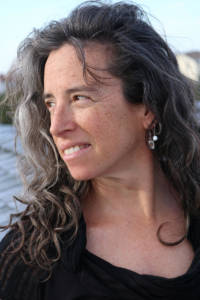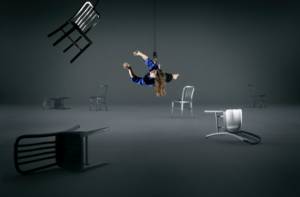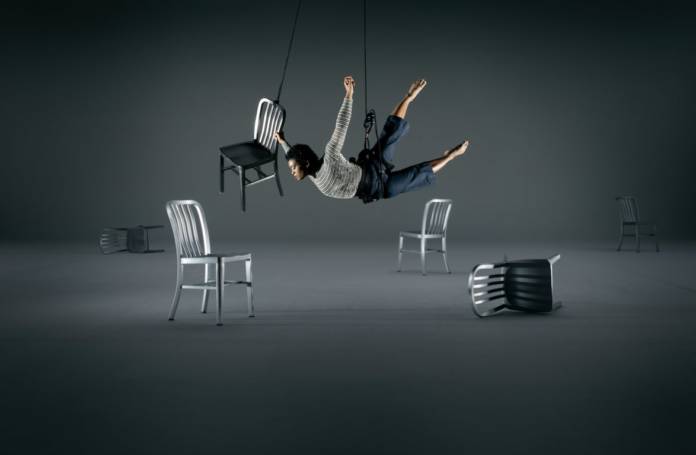“When my husband was first sentenced, people would cross the street to avoid me,” remembers choreographer Jo Kreiter, writing to 48 Hills before her aerial dance production The Wait Room, inspired by the experience, debuts Fri/19. The stigma that surrounded Kreiter’s experience is incredible given the fact that one in four United States women has a family member who is incarcerated—a figure that rises to one in two women in the Black community.
The choreographer’s work revolves around physical embodiment of political issues. In this case, the painful experience of her husband’s absence stirred in her the instinct to make art, but throughout her career inspiration has come from many sources. Those familiar with Kreiter’s 2018 work, strung up the facade of the Tenderloin’s gentrification-witnessing Cadillac Hotel in the Tenderloin, will recognize her and Flyaway Productions’ tactic of employing public space to compel dialogue on issues too immediate to relegate to interior stage.
The Wait Room will be staged for eight free productions in a vacant lot in front of United Nations Plaza, starting Fri/19 by a cast of six women, half of whom have an incarcerated family member themselves. The piece is the first installation in Kreiter’s “Decarceration Trilogy”, a triptych of work whose edges go far beyond her family’s dolorous experience. (Her husband is now out on probation, a shift in situation in the prison industrial complex.)
A white woman, Kreiter linked with the Essie Justice Group when her husband’s family needed community support and found a largely women-of-color network of people fighting to transform the incarceration system and bolster those who have been left to carry on while a loved one serves time. She discussed the particular physical affects of incarceration adjacency with us, and the potency of the Essie Justice Group.
48 HILLS The piece is built around your own experience having a husband who has been incarcerated. Can you talk about some of the physical conditions and situations that inspired specific movements in The Wait Room?
JO KREITER When you visit your loved one in prison, you have to start the day really early in the morning. You arrive tired. If you’ve brought a young child, which I did regularly, you run into the problem of having nothing to do as you wait for hours in line. You can only bring in your car key, your ID and a see-through bag of quarters. You cannot bring any kind of game or book for your child. So my son and I spent a lot of time playing hand games. Double O Seven. Rock Paper Scissors. And Chopsticks. Sometimes you get there and the prison is on lockdown and you are turned away. Sometimes you are turned away because you have an underwire in your bra and that is not allowed. Sometimes you don’t have the right pants on and the corrections officers won’t let you in.
We open the piece with a section called “Visiting.” We interviewed six women from Essie Justice Group for the project, and the opening reflects their experiences, as well as my own. Megan Comfort, who wrote a book called Doing Time Together, describes visiting in the context of ceremonies of degradation. The section is made up of several ceremonies, as we reflect the degradation and dehumanization cast onto families who visit their loved ones. In the piece we play chopsticks as one of our ceremonies. We abstract it in time and space as part of the choreography.

The process of living under secondary incarceration—meaning living as a woman with an incarcerated loved one—radicalized me. I didn’t truly understand the imperative of prison abolition until I lived through a six-year prison sentence, as a family member, on the outside. The dehumanization is so real for both families and for those living inside the walls. And the shame is so real. When my husband was first sentenced, people would cross the street to avoid me. Close friends begged me to leave him. My world got very small. My experience with shame is pretty universally felt by women with incarcerated loved ones. In the dance, we created a whole section dedicated to shame and isolation. Dancer Bianca Cabrera plays a women alone on a tilted ledge, with no one but herself as company.
48 HILLS How did you work with the dancers to prepare them for communicating such a complex topic?
JO KREITER Half the cast has a family member who is or has been incarcerated, so they had their own experiences to call upon. Equally, many of the dancers have been with Flyaway [Productions, the “apparatus-based” dance company where Kreiter serves as artistic director] for a long time. So as I lived through secondary incarceration, they lived through it with me, at my side, as artists and collaborators in various projects over the last several years. They watched me struggle. They watched me fight back. They watched me fall down. They helped keep me connected to my own strength. Finally, composer Pamela Z and I created a series of interviews of Essie women whose fathers, partners and/or sons are incarcerated. The dancers listened to the tapes, to learn more about the women whose experience they are embodying.

48 HILLS Why did you think it was important to take on proximity to incarceration, rather than incarceration itself?
JO KREITER I love this question. My first answer is data-driven. One in four women, and nearly one in two black women has a family member who is in prison. This is the statistic that Essie Justice Group has verified. It includes trans and gender-diverse women. So proximity is common. And proximity is gendered, as these women are being asked to be in collusion with a system that is simultaneously bringing us down.
There is a lot to say about women’s experiences behind bars. There are some amazing activists—those who are formerly incarcerated in particular—who are raising public awareness about crucial issues. But my own experience is as a women with an incarcerated partner, as he was herded into prisons around the country. The Wait Room focuses on proximity because mass incarceration is a violent system that damages so many more people than the ones who are locked behind the walls.
48 HILLS How did you get involved in the Essie Justice Group? What compelled you to partner with them?
JO KREITER I first learned about Essie when my husband was sentenced. I went rooting around on the internet for support and Essie came up in my search. I was not able to participate with Essie, though, until my partner came home on probation. I wanted to take the training but was deep in survival mode as a single mom negotiating the trauma of my partner’s incarceration. I simply didn’t have the bandwidth to spend one night each week for nine weeks away from work or my son. I regret not pushing myself to connect with Essie sooner. They are a powerhouse group of women who laugh and cry and fight back.
I am honored to be a member of Essie, and also thrilled to engage them in a partnership. I’ve spent a lot of the last 25 years building coalitions with women marginalized by gender, race, class, and workplace inequities. Essie has connected me to a sisterhood of mostly POC women who’ve been mounting extremely effective political actions to end mass incarceration since 2014. They are a group of women who share my prison experience, who can expand on the connections between racism and the Prison Industrial Complex, and who can help me along as an artist, to illuminate the daily steps of secondary incarceration and communicate our triumphs as well.
THE WAIT ROOM
Fri/19-April 27, 8pm (2pm Saturday matinees), free
1125 Market, SF.
More info here.





